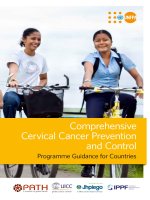Comprehensive Cervical Cancer Control: A guide to essential practice potx
Bạn đang xem bản rút gọn của tài liệu. Xem và tải ngay bản đầy đủ của tài liệu tại đây (3.46 MB, 284 trang )
Comprehensive
Cervical Cancer Control
A guide to essential practice
ISBN 92 4 154700 6 (NLM classification: WP 480)
ISBN 978 92 4 154700 0
© World Health Organization 2006
All rights reserved. Publications of the World Health Organization can be obtained from
WHO Press, World Health Organization, 20 Avenue Appia, 1211 Geneva 27, Switzerland
(tel.: +41 22 791 3264; fax: +41 22 791 4857; e-mail: ). Requests
for permission to reproduce or translate WHO publications – whether for sale or for
noncommercial distribution – should be addressed to WHO Press, at the above address
(fax: +41 22 791 4806; e-mail: ).
The designations employed and the presentation of the material in this publication do
not imply the expression of any opinion whatsoever on the part of the World Health
Organization concerning the legal status of any country, territory, city or area or of
its authorities, or concerning the delimitation of its frontiers or boundaries. Dotted
lines on maps represent approximate border lines for which there may not yet be full
agreement.
The mention of specific companies or of certain manufacturers’ products does not imply
that they are endorsed or recommended by the World Health Organization in preference
to others of a similar nature that are not mentioned. Errors and omissions excepted, the
names of proprietary products are distinguished by initial capital letters.
All reasonable precautions have been taken by the World Health Organization to verify
the information contained in this publication. However, the published material is being
distributed without warranty of any kind, either expressed or implied. The responsibility
for the interpretation and use of the material lies with the reader. In no event shall the
World Health Organization be liable for damages arising from its use.
Printed in Switzerland
1.Uterine cervical neoplasms - diagnosis. 2.Uterine cervical neoplasms -
prevention and control. 3.Uterine cervical neoplasms – therapy. 4.Guidelines.
I.World Health Organization.
WHO Library Cataloguing-in-Publication Data
Comprehensive cervical cancer control : a guide to essential practice.
ACKNOWLEDGEMENTS
This practice guide has been developed by the Department of Reproductive Health and
Research and the Department of Chronic Diseases and Health Promotion of the
World Health Organization (WHO), with the International Agency for Research on
Cancer (IARC), the Pan American Health Organization (PAHO), and in collaboration with
the Alliance for Cervical Cancer Prevention (ACCP), the International Atomic Energy
Agency (IAEA), the International Federation of Gynecology and Obstetrics (FIGO), the
International Gynecologic Cancer Society (IGCS), and the European Association for
Palliative Care (EAPC).
The guide is based on the work of a large group of experts, who participated in
consultations or reviews. WHO gratefully acknowledges the contributions of:
• themembersoftheTechnicalAdvisoryGroup(TAG)panel:RoseAnnAugust,
Paul Blumenthal, August Burns, Djamila Cabral, Mike Chirenje, Lynette Denny,
Brahim El Gueddari, Irena Kirar Fazarinc, Ricardo Fescina, Peter Gichangi,
Sue Goldie, Neville Hacker, Martha Jacob, Jose Jeronimo, Rajshree Jha,
Mary Kawonga, Sarbani Ghosh Laskar, Gunta Lazdane, Jerzy Leowski, Victor Levin,
Silvana Luciani, Pisake Lumbiganon, Cédric Mahé, Anthony Miller, Hextan Ngan,
Sherif Omar, Ruyan Pang, Julietta Patnick, Hervé Picard, Amy Pollack,
Françoise Porchet, You-Lin Qiao, Sylvia Robles, Eduardo Rosenblatt,
Diaa Medhat Saleh, Rengaswamy Sankaranarayanan, Rafaella Schiavon,
Jacqueline Sherris, Hai-Rim Shin, Daiva Vaitkiene, Eric Van Marck,
Bhadrasain Vikram, Thomas Wright, Matthew Zarka, Eduardo Zubizarreta.
• theexternalreviewers:JeanAhlborg,MarcArbijn,XavierBosch,ElsieDancel,
Wachara Eamratsameekool, Susan Garland, Namory Keito, Ntokozo Ndlovu,
Twalib Ngoma, Abraham Peedicayil, Rodrigo Prado, John Sellors, Albert Singer,
Eric Suba, Jill Tabutt Henry.
• themanyreviewerswhoassistedineld-testingtheguideinChina,Egypt,India,
Lithuania, Trinidad, and Zimbabwe.
Reproductive Health
and Research
FIGO
ACCP
IARC
IGCS
PAHO
WHO coordinating team:
Patricia Claeys, Nathalie Broutet, Andreas Ullrich.
WHO writing and designing team:
Kathy Shapiro, Emma Ottolenghi, Patricia Claeys, Janet Petitpierre.
Core group:
Martha Jacob (ACCP), Victor Levin (IAEA), Silvana Luciani (PAHO), Cédric Mahé (IARC),
Sonia Pagliusi (WHO), Sylvia Robles (PAHO), Eduardo Rosenblatt (IAEA), Rengaswamy
Sankaranarayanan (IARC), Cecilia Sepulveda (WHO), Bhadrasain Vikram (IAEA), as well as
the members of the coordinating and writing teams.
WHO is grateful to the Flemish Government (Belgium) for providing the main funding for
this document. Other donors, who are also gratefully acknowledged, include the Alliance
for Cervical Cancer Prevention, the International Atomic Energy Agency, Grounds for
Health, and the European Coordination Committee of the Radiological and Electromedical
Industry.
CONTENTS
Abbreviations and acronyms used in this Guide 1
Preface 3
Introduction 5
About the Guide 5
Levels of the health care system 9
Essential reading 10
WHO Recommendations 11
Chapter 1: Background 13
Key points 15
About this chapter 15
Why focus on cervical cancer? 16
Who is most affected by cervical cancer? 18
Barriers to control of cervical cancer 19
The four components of cervical cancer control 20
A team approach to cervical cancer control 22
Additional resources 23
Chapter 2: Anatomy of the female pelvis and natural history
of cervical cancer 25
Key points 27
About this chapter 27
Anatomy and histology 28
Natural history of cervical cancer 35
Additional resources 42
Chapter 3: Health promotion: prevention, health education and
counselling 43
Key points 45
About this chapter 45
Health promotion 45
The role of the provider 46
Prevention of HPV infection 46
Health education 48
Counselling 53
Health education and counselling at different levels 55
Additional resources 56
Practice sheet 1: Health education 59
Practice sheet 2: Frequently asked questions (FAQs) about
cervical cancer 63
Practice sheet 3: How to involve men in preventing cervical cancer . 67
Practice sheet 4: Counselling 69
Practice sheet 5: How to use male and female condoms 73
Chapter 4: Screening for cervical cancer 79
Key points 81
About this chapter 81
Role of the health care provider 81
Screening programmes 83
Screening tests 92
Follow-up 101
Screening activities at different levels of the health system 103
Additional resources 105
Practice sheet 6: Obtaining informed consent 107
Practice sheet 7: Taking a history and performing a pelvic
examination 109
Practice sheet 8: Taking a Pap smear 115
Practice sheet 9: Collecting samples for HPV DNA testing 119
Practice sheet 10: Visual screening methods 123
Chapter 5: Diagnosis and management of precancer 125
Key points 127
About this chapter 127
Role of the provider 127
Management options for precancer 129
Diagnosis 130
Treatment of precancer 133
Follow-up after treatment 142
Diagnosis and treatment activities at different levels 143
Additional resources 145
Practice sheet 11: Colposcopy, punch biopsy and endocervical
curettage 147
Practice sheet 12: Cryotherapy 151
Practice sheet 13: Loop electrosurgical excision procedure (LEEP) . 155
Practice sheet 14: Cold knife conization 161
Chapter 6: Management of invasive cancer 165
Key points 167
About this chapter 167
The role of the provider 167
Diagnosis 169
Cervical cancer staging 170
Principles of treatment 176
Treatment modalities 179
Patient follow-up 186
Special situations 187
Talking to patients who have invasive disease and to their families 188
Management of invasive cancer: activities at different levels 190
Additional resources 191
Practice sheet 15: Hysterectomy 193
Practice sheet 16: Pelvic teletherapy 199
Practice sheet 17: Brachytherapy 205
Chapter 7: Palliative care 209
Key points 211
About this chapter 211
The role of the health care provider 212
A comprehensive approach to palliative care 214
Managing common symptoms of extensive cancer 217
Death and dying 220
Organization of palliative care services 222
Palliative care at different levels of the health system 223
Additional resources 224
Practice sheet 18: Pain management 225
Practice sheet 19: Home-based palliative care 231
Practice sheet 20: Managing vaginal discharge and fistulae
at home 237
Annex 1: Universal precautions for infection prevention 241
Annex 2: The 2001 Bethesda system 245
Annex 3: How is a test’s performance measured? 247
Annex 4: Flowcharts for follow-up and management of patients
according to screen results 249
4a. Standard approach and example based on pap smear screening . 249
4b. The “screen-and-treat” approach, based on visual inspection
with acetic acid as screening test 251
Annex 5: Standard management of cervical precancer 253
Annex 6: Cervical cancer treatment by stage 255
6a. Treatment of microinvasive carcinoma: Stage IA1 and IA2 255
6b. Treatment of early invasive cancer: Stage IB1 and IIA
<
4 cm 256
6c. Treatment of bulky disease: Stage IB2-IIIB 257
6d. Treatment of Stage IV 258
6e. Cervical cancer management during pregnancy 259
Annex 7: Sample documents 261
7a. Sample letter to patient with an abnormal Pap smear
who did not return for results at expected time 261
7b. Sample card that can be used as part of a system
to track clients who need a repeat Pap smear. 262
7c. Sample card that can be used as part of a system to
track patients referred for colposcopy 263
7d. Sample letter informing referring clinic of the outcome
of a patient’s colposcopy. 264
Annex 8: Treatment of cervical infections and pelvic inflammatory
disease (PID) 265
8a. Treatment of cervical infections 265
8b. Outpatient treatment for PID 266
Annex 9: How to make Monsel’s paste 267
Glossary 269
1
ABBREVIATIONS AND ACRONYMS USED IN THIS GUIDE
AGC atypical glandular cells
AIDS acquired immunodeficiency syndrome
AIS adenocarcinoma in situ
ANC antenatal care
ASC-H atypical squamous cells: cannot exclude a high-grade
squamous intra-epithelial lesion
ASC-US atypical squamous cells of undetermined significance
CHW community health worker
CIN cervical intraepithelial neoplasia
CIS carcinoma in situ
CT computerized tomography
DNA deoxyribonucleic acid
EBRT external beam radiotherapy
ECC endocervical curettage
FAQ frequently asked question
FIGO International Federation of Gynecology and Obstetrics
FP family planning
HBC home-based care
HDR high dose rate
HIV human immunodeficiency virus
HPV human papillomavirus
HSIL high-grade squamous intraepithelial lesion
HSV herpes simplex virus
IEC information, education and communication
IUD intrauterine device
LDR low dose rate
LEEP loop electrosurgical excision procedure
LLETZ large loop excision of the transformation zone
LSIL low-grade squamous intraepithelial lesion
MRI magnetic resonance imaging
2
NCCP national cancer control programme
NSAID nonsteroidal anti-inflammatory drug
OC oral contraceptives
PHC primary health care
PID pelvic inflammatory disease
PS practice sheet
RTI reproductive tract infection
SCJ squamocolumnar junction
SIL squamous intraepithelial lesion
STI sexually transmitted infection
VIA visual inspection with acetic acid
VILI visual inspection with Lugol’s iodine
3
PREFACE
Cancer is being diagnosed more and more frequently in the developing world. The
recent World Health Organization report, Preventing chronic diseases: a vital investment,
projected that over 7.5 million people would die of cancer in 2005, and that over 70%
of these deaths would be in low- and middle-income countries. The importance of the
challenge posed by cancer was reiterated by the World Health Assembly in 2005, in
Resolution 58.22 on Cancer Prevention and Control, which emphasized the need for
comprehensive and integrated action to stop this global epidemic.
Cervical cancer is the second most common type of cancer among women, and was
responsible for over 250 000 deaths in 2005, approximately 80% of which occurred
in developing countries. Without urgent action, deaths due to cervical cancer are
projected to rise by almost 25% over the next 10 years. Prevention of these deaths by
adequate screening and treatment (as recommended in this Guide) will contribute to the
achievement of the Millennium Development Goals.
Most women who die from cervical cancer, particularly in developing countries, are
in the prime of their life. They may be raising children, caring for their family, and
contributing to the social and economic life of their town or village. Their death is both a
personal tragedy, and a sad and unnecessary loss to their family and their community.
Unnecessary, because there is compelling evidence – as this Guide makes clear – that
cervical cancer is one of the most preventable and treatable forms of cancer, as long as
it is detected early and managed effectively.
Unfortunately, the majority of women in developing countries still do not have access
to cervical cancer prevention programmes. The consequence is that, often, cervical
cancer is not detected until it is too late to be cured. An urgent effort is required if
this situation is to be corrected. All women have a right to accessible, affordable and
effective services for the prevention of cervical cancer. These services should be
delivered as part of a comprehensive programme to improve sexual and reproductive
health. Moreover, a concerted and coordinated effort is required to increase community
awareness about screening for the prevention and detection of cervical cancer.
A great deal of experience and evidence-based knowledge is available for the
prevention (and treatment) of cervical cancer and related mortality and morbidity.
However, until now, this information was not available in one easy-to-use guide.
This publication – produced by WHO and its partners – is designed to provide
comprehensive practical advice to health care providers at all levels of the health care
system on how to prevent, detect early, treat and palliate cervical cancer. In particular,
the Guide seeks to ensure that health care providers at the primary and secondary
levels will be empowered to use the best available knowledge in dealing with cervical
cancer for the benefit of the whole community.
4
We call on all countries that have not already done so to introduce effective, organized
control programmes for cervical cancer as recommended in this Guide. Together, we can
significantly reduce the heavy burden of this disease and its consequences.
Catherine Le Gales-Camus
Assistant Director-General
Noncommunicable Diseases and Mental Health
Joy Phumaphi
Assistant Director-General
Family and Community Health
5
INTRODUCTION
ABOUT THE GUIDE
Scope and objectives of the Guide
This Guide is intended to help those responsible for providing services aimed at
reducing the burden posed by cervical cancer for women, communities and health
systems. It focuses on the knowledge and skills needed by health care providers, at
different levels of care, in order to offer quality services for prevention, screening,
treatment and palliation of cervical cancer. The Guide presents guidelines and up-
to-date, evidence-based recommendations covering the full continuum of care. Key
recommendations are included in each chapter; a consolidated list is given on pages
11–12.
The four levels of care referred to throughout this Guide are:
• thecommunity;
• thehealthcentreorprimarycarelevel;
• thedistricthospitalorsecondarycarelevel;
• thecentralorreferralhospitalortertiarycarelevel.
A detailed description of each level is given on page 9.
The Guide does not cover programme management, resource mobilization, or the
political, legal and policy-related activities associated with cervical cancer control.
Adaptation
This Guide provides broadly applicable recommendations and may need to be adapted
to local health systems, needs, language and culture. Information and suggestions on
adaptation are available elsewhere (see list of additional resources). The Guide and
its recommendations can also be used as a basis for introducing or adapting national
protocols, and for modifying policies and practices.
The target audience
This Guide is intended primarily for use by health care providers working in cervical
cancer control programmes in health centres and district hospitals in settings with
limited resources. However, it may also be of interest to community and tertiary-level
providers, as well as workers in other settings where women in need of screening or
treatment might be reached.
The health care team
In an ideal cervical cancer control programme, providers work as a team, performing in
a complementary and synergistic manner, and maintaining good communication within
6
and between levels. In some countries, the private and the nongovernmental sectors are
important providers of services for cervical cancer. Providers in these sectors should be
integrated in the health care team where relevant. Some possible roles of health care
providers at different levels of the health care system are as follows:
• Communityhealthworkers(CHWs)maybeinvolvedinraisingawarenessofcervical
cancer in the community, motivating and assisting women to use services, and
following up those who have been treated at higher levels of care when they return
to their community.
• Primaryhealthcareproviderscanpromoteservicesandconductscreeningand
follow-up, and refer women to higher levels as necessary.
• District-levelprovidersperformarangeofdiagnosticandtreatmentservices,and
refer patients to higher and lower levels of care.
• Central-levelproviderscareforpatientswithinvasiveandadvanceddisease,and
refer them back to lower levels, when appropriate.
Using the Guide
This Guide can be used by health care providers, supervisors and trainers:
• asareferencemanual,providingbasic,up-to-dateinformationaboutprevention,
screening, diagnosis and treatment of cervical cancer;
• todesignpreserviceandin-serviceeducationandtraining,andasaself-education
tool;
• asareviewofpreventionandmanagementofcervicalcancer;
• tondevidence-basedadviceonhowtohandlespecicsituations;
• tounderstandhowtherolesofdifferentprovidersarelinkedwitheachotheratthe
various levels of the health care system.
The Guide can be used as a whole, or users can focus on the sections that are relevant
to their practice. Even if it is used selectively, we strongly recommend that readers
should review the recommendations appearing on pages 11–12 in their entirety.
The contents
The Guide is composed of seven chapters and associated practice sheets, nine annexes
and a glossary.
Each chapter includes:
• adescriptionoftheroleandresponsibilitiesofrst-andsecond-levelprovidersin
relation to the specific topic of the chapter;
• astoryillustratingandpersonalizingthetopicofthechapter;
7
• essentialbackgroundinformationonthesubjectofthechapter,followed
by discussion of established and evolving practices in clinical care, and
recommendations for practice, as appropriate;
• informationonservicesateachofthefourlevelsofthehealthcaresystem;
• counsellingmessagestohelpproviderscommunicatewithwomenaboutthe
services they have received and the follow-up they will need;
• alistofadditionalresources.
Most of the chapters have associated practice sheets. These are short, self-contained
documents containing key information on specific elements of care that health care
providers may need to deliver, for example, how to take a Pap smear or how to perform
cryotherapy. Counselling is included as an integral part of each procedure described.
Practice Sheets 13–17 relate to procedures carried out by specialists. The information
provided in these sheets can help other health care providers to explain the procedure
to the patient, to counsel her, and to treat particular problems that may arise after the
intervention.
The practice sheets can be individually copied or adapted.
1
The annexes detail specific practice components, using internationally established
protocols (e.g. management flowcharts and treatment protocols) and strategies to
enhance service quality (e.g. infection prevention).
The glossary contains definitions of scientific and technical terms used in the Guide.
Key principles and framework for this document
Principles
The approach of this Guide is based on the following principles:
• therightofeveryonetoequitable,affordableandaccessiblehealthcare;
• reproductivehealthrights,asformulatedintheProgrammeofActionadoptedatthe
1994 International Conference on Population and Development in Cairo (paragraph
7.6);
• theethicalprinciplesofjustice,autonomyandbenecenceasdenedanddiscussed
in the Declaration of Helsinki and the International Ethical Guidelines for Biomedical
Research Involving Human Subjects prepared by the Council of International
Organizations of Medical Sciences (CIOMS) and WHO;
1
The practice sheets are not intended to be used by a novice to learn how to carry out a procedure.
They are intended as job aids, to remind trained providers of the essential steps and to help them to
educate, counsel and correctly explain services to women and their families. They can also be used as
a checklist to document competency as part of supportive supervision.
8
• agender-basedperspective:thediscussionconsidersgender-relatedfactorsthat
may affect the power balance between men and women, reduce women’s power of
self-determination, and affect the provision and receipt of services.
Underlying framework
The following assumptions and context underlie the presentation of material in this
Guide:
• Alltheinterventionsrecommendedarebasedonsoundscienticevidence.
• Comprehensivecontrolofcervicalcancershouldbeundertakeninthecontextofa
national cancer control programme (NCCP).
• Cervicalcancercontrolshould,asfaraspossible,beintegratedintoexistingsexual
and reproductive health services at the primary health care level.
• Screeningandearlydiagnosiswillleadtoreducedmorbidityandmortalityonlyif
they are integrated with follow-up and management of all preinvasive lesions and
invasive cancers detected.
• Resourcesareavailableorwillbedevelopedtostrengthenhealthinfrastructure,and
make available the following:
– well trained providers;
– necessary equipment and supplies;
– a functional referral system and communication between different teams,
services, health system levels and the community;
– a quality assurance system.
The Guide’s development
Evidence for the information in the Guide is based on the following:
• areviewoftherelevantliterature;
• inputfromaTechnicalAdvisoryGroup(TAG),consistingofexpertsindifferent
disciplines from developing and developed countries, who elaborated and reviewed
the Guide;
• extensivewrittenreviewofdraftsbyalargenumberofexternalexperts;
• reviewbyWHOstaff;
• informationprovidedbytheInternationalAgencyforResearchonCancer(IARC),
including the handbook, Cervix cancer screening, published in 2005;
• in-countryreview(pre-eld-testing)insixcountries.
The evidence base for all the guidance presented in this Guide will be published
separately as a companion document.
9
LEVELS OF THE HEALTH CARE SYSTEM
2
COMMUNITY LEVEL
Includes individuals and organizations; community-based,
faith-based and other nongovernmental organizations; and
community and home-based palliative care services. Also
included are health posts or “cases de santé”, usually staffed by
an auxiliary nurse or community health worker.
HEALTH CENTRE – PRIMARY CARE LEVEL
Refers to primary care facilities with trained staff and regular
working hours. Maternity and minimal laboratory services may
be available.
Providers at this level include nurses, auxiliary nurses or nursing
assistants, counsellors, health educators, medical assistants,
clinical officers and, sometimes, physicians.
DISTRICT HOSPITAL – SECONDARY CARE LEVEL
Typically, a hospital that provides general medical, paediatric,
and maternity services, limited surgical care, inpatient and
outpatient care, and, sometimes, intermittent specialized care.
Patients may be referred from health centres and private
practitioners in the district. Laboratory services may include
cytology and histopathology.
Providers include generalist physicians or clinical officers,
nurses, pharmacy technicians or dispensing clerks, medical
assistants, nurse assistants, and laboratory technology
assistants, possibly a gynaecologist and a cytotechnologist.
Private and mission hospitals are often present at this level.
CENTRAL OR REFERRAL HOSPITAL – TERTIARY CARE LEVEL
Tertiary care hospitals provide general and specialized care
for complex cases and acutely ill patients, including surgery,
radiotherapy and multiple outpatient and inpatient services.
General medical, acute and chronic care clinics are offered.
The most complete public-sector diagnostic and reference
laboratory services are available with pathologists and
cytotechnologists, radiology, and diagnostic imaging.
Providers may include gynaecologists, oncologists and
radiotherapists, as well as those present at lower levels of care.
In the community
At the health centre
At the district hospital
At the central hospital
2
This description does not include services and providers outside the formal health system:
traditional healers, traditional birth attendants, medicine sellers, etc., who also play important roles.
10
ESSENTIAL READING
• AllianceforCervicalCancerPrevention.Planning and implementing cervical cancer
prevention programs: a manual for managers. Seattle, WA, 2004.
• IARC.Cervix cancer screening. Lyon, IARCPress, 2005 (IARC Handbooks of Cancer
Prevention, Vol. 10).
• WHO.Cervical cancer screening in developing countries. Report of a WHO Consultation.
Geneva, 2002.
• WHO.Comprehensive cervical cancer control. A guide for essential practice, evidence
base. Geneva (in preparation).
• AllianceforCervicalCancerPrevention(www.alliance-cxca.org).
• InternationalAgencyforResearchonCancer(www.iarc.fr).
• ProgramforAppropriateTechnologyinHealth(www.path.org).
• EngenderHealth(www.engenderhealth.org).
• JHPIEGO(www.JHPIEGO.org).
• Cancer prevention and control. Resolution 58.22 of the 58th World Health Assembly
(www.who.int/gb/ebwha/pdf_files/WHA58/WHA58_22-en.pdf).
• WHOCancerControlProgramme(www.who.int/cancer).
• WHODepartmentonReproductiveHealthandResearch(www.who.int/reproductive-
health).
11
WHO RECOMMENDATIONSWHO RECOMMENDATIONS
• Healtheducationshouldbeanintegralpartofcomprehensivecervicalcancer
control.
• Cytologyisrecommendedforlarge-scalecervicalcancerscreening
programmes, if sufficient resources exist.
Recommended target ages and frequency of cervical cancer screening:
– New programmes should start screening women aged 30 years or more,
and include younger women only when the highest-risk group has been
covered. Existing organized programmes should not include women less
than 25 years of age in their target populations.
– If a woman can be screened only once in her lifetime, the best age is
between 35 and 45 years.
– For women over 50 years, a five-year screening interval is appropriate.
– In the age group 25-49 years, a three-year interval can be considered if
resources are available.
– Annual screening is not recommended at any age.
– Screening is not necessary for women over 65 years, provided the last two
previous smears were negative.
• Visualscreeningmethods(usingaceticacid(VIA)orLugol’siodine(VILI)),atthis
time, are recommended for use only in pilot projects or other closely monitored
settings. These methods should not be recommended for postmenopausal
women.
• Humanpapillomavirus(HPV)DNAtestsasprimaryscreeningmethods,atthis
time, are recommended for use only in pilot projects or other closely monitored
settings. They can be used in conjunction with cytology or other screening
tests, where sufficient resources exist. HPV DNA-based screening should not
begin before 30 years of age.
• Thereisnoneedtolimittheuseofhormonalcontraceptives,despitethe
small increased risk of cervical cancer noted with use of combined oral
contraceptives.
• Womenshouldbeofferedthesamecervicalcancerscreeningandtreatment
options irrespective of their HIV status.
• Colposcopyisrecommendedonlyasadiagnostictoolandshouldbeperformed
by properly trained and skilled providers.
continued next page
12
• Precancershouldbetreatedonanoutpatientbasiswheneverpossible.Both
cryotherapy and the loop electrosurgical excision procedure (LEEP) may
be suitable for this purpose, depending on eligibility criteria and available
resources.
• Histologicalconrmationofcervicalcancerandstagingmustbecompleted
before embarking on further investigations and treatment.
• Surgeryandradiotherapyaretheonlyrecommendedprimarytreatment
modalities for cervical cancer.
• Brachytherapyisamandatorycomponentofcurativeradiotherapyofcervical
cancer.
• Surgeryfortreatmentofcervicalcancershouldbeperformedonlybysurgeons
with focused training in gynaecological cancer surgery.
• Theneedsofwomenwithincurablediseaseshouldbeaddressedbyusing
existing palliative care services or establishing new ones. Providers at all care
levels need to be trained and must have the resources necessary to manage
the most common physical and psychosocial problems, with special attention
to pain control.
• Acomprehensivecervicalcancerprogrammeshouldensurethatopioid,non-
opioid and adjuvant analgesics, particularly morphine for oral administration,
are available.
13
1
CHAPTER 1: BACKGROUND
14









